Faberge egg, an ornamented egg made by the famous house of Faberge. The number of Faberge eggs are not exactly known for some are untraced or of unknown location. The only itemized and most popular Faberge eggs are made for the Romanov Imperial family. There are fifty imperial eggs, the last two pieces are unfinished due to the start of World War I. The confiscated Imperial Faberge eggs were hidden and listed in the Armory Museum of Kremlin.
Faberge
Peter Carl Faberge is considered the greatest goldsmith during his times. The son of Gustav and Charlotte Faberge born in 1846. The name Faberge came from the old French word "favori," which means artisan or manufacturer. His father was awarded Master Goldsmith and opened a jewelry shop in Saint Petersburg.
He began his first jewelry shop just down the road from his father's old shop. He was a strict taskmaster. It was said that he would have two pieces beside his workmasters, a stamp, and a hammer. Either the jewelry would get a stamp of approval, or it is hammered and destroyed. He had two prized workmasters. These are Henry Wickstrom and Mickhael Perkhin. They completed most of the Imperial Easter egg ever made. Alexander III was very impressed with Faberge's artworks that he granted him a royal warrant making him goldsmith to the imperial crown. This, in turn, allows him to stamp the Romanov crest.
Most artworks of the house of Faberge were considered derivative, inspired by what Faberge had already seen on display except for the winter egg. The winter egg was one of the imperial eggs that resurfaced in 1913 that was found in a shoebox resting under a bed in London.
Some of the eggs that denote the true meaning of Easter are the Hen egg of 1885, the imperial resurrection egg of 1889, and the winter egg of 1913, and the Red Cross egg of 1915. A typical Easter egg made by the house of Faberge would have the mark of Faberge, the year of production and the monogram of the receiver engraved on a diamond, positioned on top of the egg. Most eggs are made from an enameled gold shell, but some are carved from a block lapis lazuli, rock crystals, silver, and later even steel.
The imperial egg was initially made to look straightforward, with surprises concealed inside. An egg to symbolize fertility and the resurrection of Christ, like how Mary Magdalene showed an egg to the then king, but as the king laugh, the egg turned into red, which signifies the resurrection of Christ.
Imperial Eggs
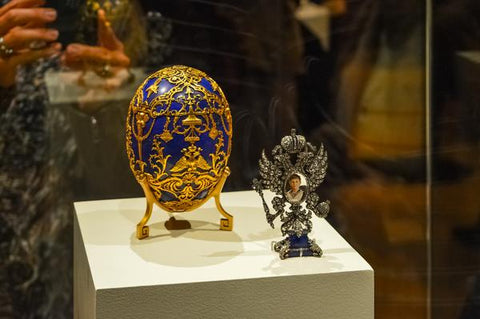
The late Tsar Alexander III wanted to surprise his spouse by giving her an Easter egg. The tsar gave a test to Faberge and another famous jeweler, they were to make a replica of the double-headed bracelet. Upon submission, the jewelry was thoroughly examined and found no fault on Faberge's piece. Faberge then was tasked to create the Easter egg to surprise his wife, Maria. Inspired by a piece that he once saw on a fair, he deigned the hen egg made by his then master-worker Erik Kolin. Due to the creativity of Faberge, the giving of Easter egg had become a yearly tradition. Here is the list of the Imperial egg made for Tsar Alexander II and Nicholas II for Dowager Maria Feodorovna and Empress Alexandria Fyodorovna.
Hen Egg
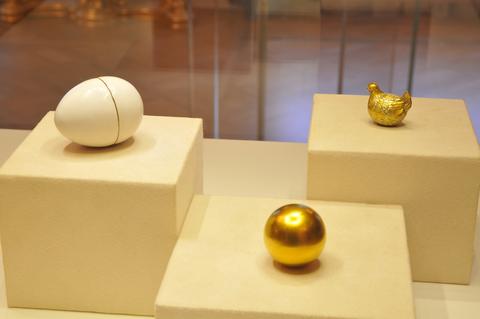
In Easter of 1885, made by Erik Koliin from the house of Faberge for Alexander III as a present to Maria Feodorovna. A gold egg enameled with translucent white that reveals an eighteen karat gold within the shell that holds a smaller golden egg yolk. Within the yolk comes a golden hen with ruby eyes, it holds a minute model of the Royal state staff and a ruby red drop. The Easter egg was made to remind Maria of her home. Inspired by the egg made for her father king Christian IX. Its original cost was 4,151 silver rubles. Viktor Vekselberg is the current owner of this piece and is on display at the Faberge Saint Petersburg.
Hen in Basket Egg
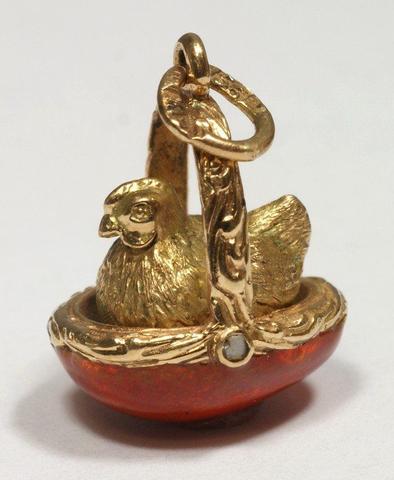
Up until the present, this ornamented Easter egg is still lost. Created in the year 1886, it was said to have a sapphire egg hanging on to the beak of a hen. Made from gold with numerous rose-cut diamonds. It was supposed to cost 2,986 silver rubles, and its location is still unknown.
Third Imperial Egg
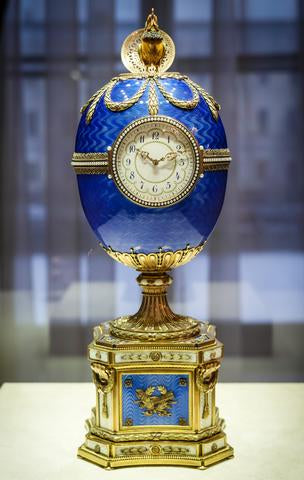
The Easter of 1887 gave birth to an Easter egg clock. Made by August Holmstrom from the house of Faberge for Alexander III as a present to Maria Feodorovna. The egg is made of an 18K gold with three corbel-like legs with a lion paw. A round cut diamond on the release button and a sapphire blue cabochon encircled by rose-cut diamond golden bows. It holds a 14K gold clock with diamonds set on each clock hand. Its originals cost was 2,160 silver rubles, currently owned by an unnamed private collector.
Angel with Egg in a Chariot
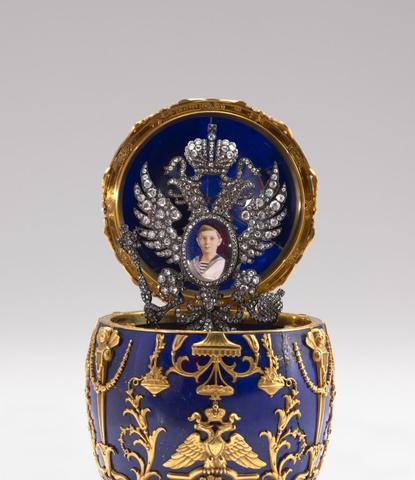
Another lost Imperial egg due to the Russian revolution, according to the inventory report in 1917, the 1888 Imperial egg was described to be an egg on a chariot being pulled by a cherub. The golden egg was said to house a clock being drawn by an angel. The egg was also adorned with diamonds and sapphire stones. Its originals cost was 2,100 silver rubles and its location is still unknown.
Necessaire Egg (1989)
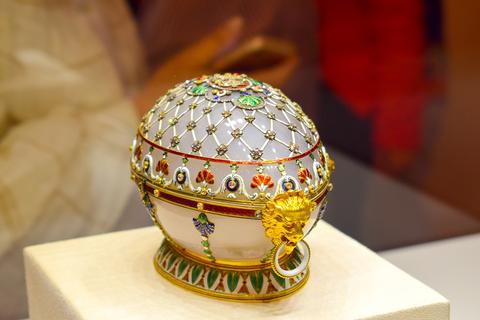
This egg was said to be inspired by an Etui or a woman's decorative box carried in her purse. Daily necessities such as scissors, needles, hairclips, and others are kept inside. Decorated with brilliant rubies, sapphire, and emerald stone. It houses thirteen pieces of tools and toiletries adorned with diamonds. As of today, the location of this piece is still unknown. Its original cost was 981 silver rubles. The last recorded detail was that an anonymous stranger bought it for 1,250 pounds in the year of 1952.
Danish Palaces Egg (1890)
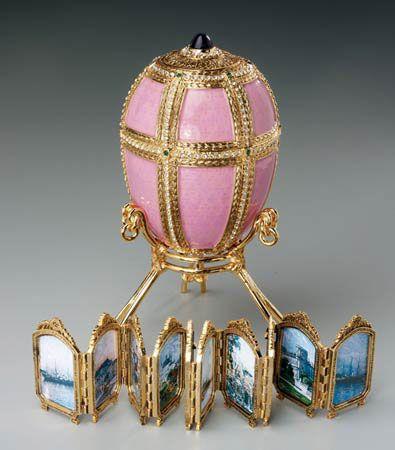
Acquired by the Matilda Geddings Gray Foundation in 1972, an enameled pink mauve egg gold egg divided into two segments. The exterior is decorated with six vertical lines of diamonds, an emerald placed at each intersecting panels. A cabochon star-shaped sapphire stone medallion at the crown of the egg with acanthus leaves decoration at the base. Inside are ten panes of watercolor paintings of the imperial ships of the Polar Star, Tsarevna, and the Emperors Villa, among other Danish palaces on mother of pearl. This egg is to commemorate the places that Tsarina Marie loved during her childhood years. Bought by Hammer Galleries in 1930 for 1500rukes and passed on to Nicholas Ludwig for $25,000. The Matilda Geddings Gray Foundation currently owns the egg, guarded in New York at the Metropolitan Art Museum.
Memory of Azov Egg (1891)

Currently owned and housed by the Kremlin Armory Museum, this imperial egg was designed by Michael Perkin and Yuri Nicolai of the house of Faberge. A yearly gift from Alexander III to his wife, Maria Fedorova. Made from bloodstone overlaid by golden rococo scrolls with diamonds and golden flowers. The gold bezel is adorned with ruby and two diamonds. This imperial egg houses a min replica of the Pamiat Azova made of 18 karat gold that rest on a slice of natural aquamarine the engineering of mast are collapsible so as the ship can fit right back inside the egg. This piece commemorates the expedition of Tsarevich Nicholas and the Grand Duke of George on the battleship Pamiat Azova that lead to the attempted slaying of Tsarevitch.
Diamond Trellis Egg (1892)

Privately owned by the couple Artie and Dorothy McFerrin, they bought this egg for 4,750 silver rubles. The facade of the egg is made of jadeite lined with white satin fabric, enclosed with a matrix of rose-cut diamonds, three silver putti base that symbolized the three sons of the royal couple. The egg houses an automaton of an elephant made of ivory, a diamond-paved gold tower on its back, this is to commemorate the mark of the Order of the Elephant, which is the h highest-ranked honor of Denmark.
Caucasus Egg (1893)
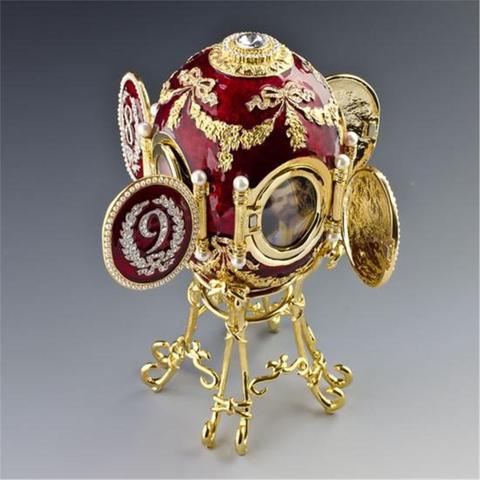
Made by Mikhail Perkhin of the house of Faberge, an imperial egg made from various materials such as gold, silver m diamonds, and rock crystals and watercolor on ivory. It houses miniature paintings of the Grand duke to commemorate his stay in Abastuman, a hunting ground for the royals. Matilda Geddings Gray Foundation currently owns this piece.
Renaissance Egg
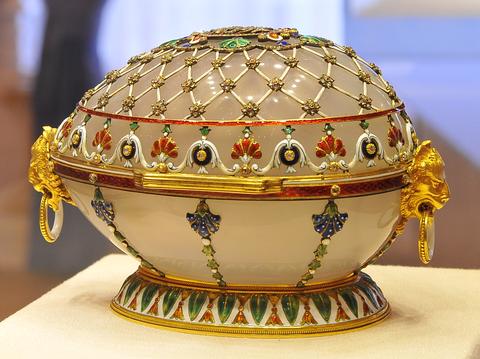
This was the last imperial egg presented to Maria before Alexander's premature death in 1894. Decorated agate egg made by Mikhail Perkhin from the house of Faberge, the original cost of this egg was 4,750 rubles. Currently owned by Viktor Vekselberg, a Russian oligarch who bought nine of the imperial eggs for $100 million. The shell was said to house the resurrection egg, for it fits the egg perfectly. It was only in the year 2004, when the two were displayed together that the similarities were seen such as the same enameling and decoration. The resurrection egg also does not have an inventory number backing the theory that it is supposed to be the surprise-hidden in the renaissance egg. The resurrection egg has a rock crystal shell with a miniature Christ standing on top of his tomb. One of the imperial egg that displays a purely religious theme.
Rosebud Egg
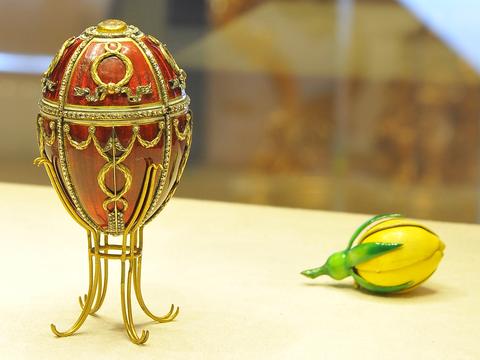
Created for Nicholas II to be presented to Empress Alexandra in the year 1895, an imperial egg that houses a small diamond –set royal crown that signifies the Empress's new life. The exterior of the egg is strawberry red in color decorated with a diamond arrow of cupid. It holds an enameled yellow rosebud enameled in matte finish to make it more natural, also symbolizes the couple's first Easter as a married couple and their love for one another. The original cost of this imperial egg was 3,250 rubles. One of the nine eggs currently owned by Victor Vekselberg.
Blue Serpent Clock Egg
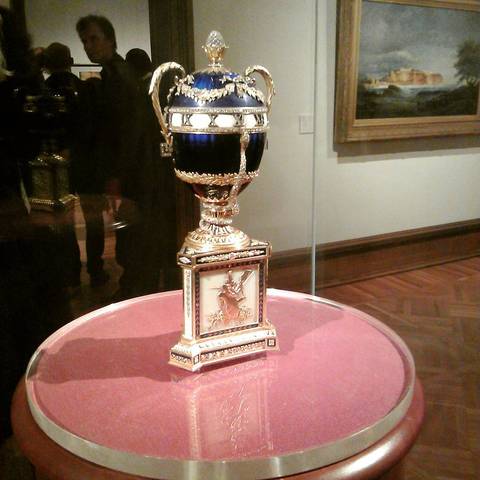
From Nicholas II to Maria Feodorovna crafted by Mikhail Perkhin in the year 1895. This piece is part of the Albert II of Monaco Collection. This specific imperial egg does not contain anything inside of it. The enameled translucent blue egg is decorated with diamonds paved gold bands set on the top and the bottom of the egg. It is raised on three-legged panels with four colors with a serpent facing up, pointing its head and tongue to the roman numerals that indicate the time. This is a working clock with a rotating white enamel to tell the time. Previously thought to be the third imperial egg, but the discovery of the third egg proved that it was not, backed by the fact this piece does not contain any sapphire stone unlike what was stated in the inventory.
The original cost was 4,500 rubles and was later bought by Stavros Niarchos for 64,103 pounds. He then gave it as a gift to Prince Rainier III and was later passed on to Prince Albert II of Monaco.
Egg with Revolving Miniatures

Also known as the Rock egg, an imperial piece made by Mikhail Perkhin from the house of Faberge for Empress Alexandria in the year 1896. The shell is made of a halved rock crystal braced by an emerald green enameled gold. A 27K Siberian Emerald stone sits on top of the apex of the egg.
The egg houses 12-minute paintings of place significant to the Empress that commemorates the areas where the courtship between Nicholas and Alexandria happened. The Siberian emerald engages the device to rotate the miniature inside the egg. Its original cost was 6,750 rubles, was later bought by Lillian Thomas Pratt for $55,000, and is now housed on the Virginia Museum of Fine Arts.
Twelve Monogram Egg
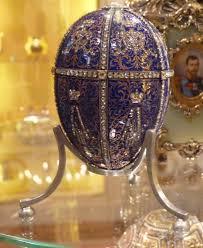
From Nicholas the II to Maria Feodorovna in the year 1896, made by Mikhail Perkhin from the house of Faberge. One of the four special imperial eggs that commemorates the former Tsar, Alexander III. Also recognized as the Alexander III Portraits, Egg described to house six portraits Tsar Alexander III painted on ivory fixed on sapphire stones; these miniatures have not been found. The outer shell is defined to be a gold egg enameled with dark blue color crowned with diamond; it has six gold panels decorated with rose-cut diamonds with monograms of Alexander II and Maria Feodorovna. The original cost was 3,575 rubles and was later bought by Marjorie Merriweather for $1,739.13 and is currently housed on the Hill wood Museum in Washington
Imperial Coronation

Made by Mikhail Perkhin from the house of Faberge, created for From Nicholas II to Empress Alexandria in the year 1897. A gold egg enameled with translucent lime yellow to replicate the robe worn by the Tsars. Crowned by a large diamond set on a cluster of 10 diamonds, a monogram of the Empress can be seen on the base table of the diamond crown. The imperial egg houses a 4-inches long exact replica of the imperial coach that Alexandra rode to Uspensky Cathedral. It took three years for the goldsmiths to complete the life-like model of the coach that was used to bring Tsarina Alexandria her coronation. It was said that the makers had to cut under the original coach for oriental silk was no longer manufactured by that time. This egg was to commemorate the historical coronation of the last Romanov patriarchs. The initial cost was 5,650 rubles and was later bought by Viktor Vekselberg as one of the nine imperial eggs he had acquired.
Mauve Egg Surprise
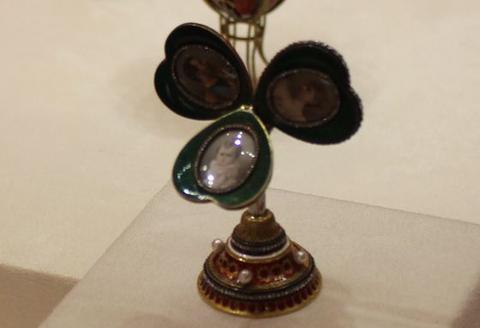
Created for Nicholas II to Maria Feodorovna in the year 1897. The exterior of the egg is still missing, but the surprise inside is a three heart-shaped photos frame that opens as a three-leaf clover. Decorated with rose-cut diamonds with red, white, and green enamels. It has a solid stem, and white laurel leaves with a red enameled base. The original cost was 3,250 rubles, Viktor Vekselberg currently owns this piece.
Lilies of the Valley
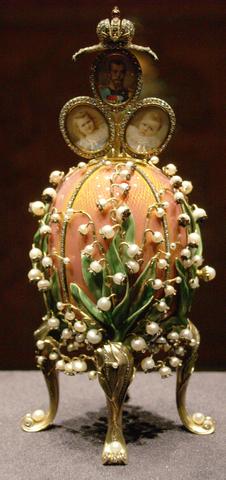
Made by Mikhail Perkhin from the house of Faberge for Nicholas II to Empress Alexandria in the year 1898. Styled using Art nouveau, the gold egg is topped with pink enamel and adorned with pearls of different size to represent a bud to a full-grown flower. Supported by four legs with green leaves that climb up the body adorned with rose-cut diamonds, and rubies. It houses three portraits of Nicholas II with his 2 daughters, namely; Duchess Olga and Duchess Tatiana. Viktor Vekselberg is the current owner of this piece. Its original cost was 6,700 rubles, one of the nine imperial eggs that cost $100 million bought by Viktor Vekselberg.
Pelican

Crafted by Mikhail Perkhin from the house of Faberge for Nicholas II to Maria Fyodorovna in the year 1898. Made from red gold engraved with patterns with the empire style. The egg extends to eight pearl-bordered frames of paintings if institutions sponsored by the Empress, an opalescent gray pelican feeding her chicks surmounts the jeweled egg that denotes motherhood. Its original cost was 3600 rubles and was bought by Lillian Thomas Pratt for $500.
Bouquet of Lilies Clock Egg
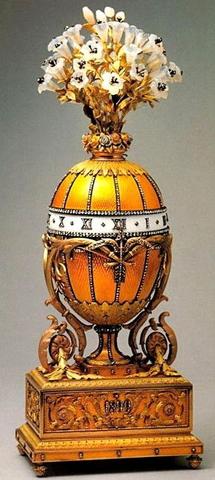
Mikhail Perkhin, from the house of Faberge for Nicholas II to Empress Alexandria Fyodorovna in the year 1899, created the Madonna Lily Clock Egg. The egg was said to house a ruby pendant adorned with rose-cut diamonds, but sadly, the surprise still lost. The exterior of the egg is described to be an egg-shaped clock supported by a rectangular block coated with translucent enamel. The egg is divided into 12 segments defined by the diamond-paved bands. A drawn bow with an arrow is used to tell the time fixed on to an onyx base. Madonna Lilies is placed on the crown of the egg with three rose-cut diamonds and tinted gold stems. The flowers denote purity, innocence, and love. Its original cost was 6,750 rubles and is currently housed in the Armory Museum of the Kremlin.
Pansy Egg
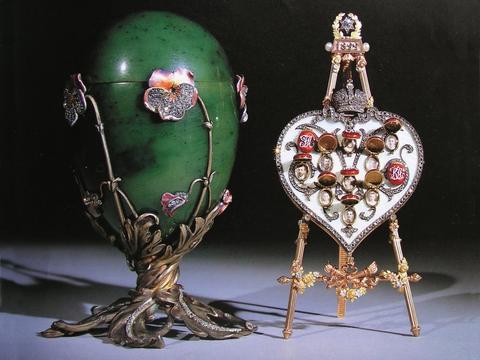
Made by Mikhail Perkhin from the house of Faberge for Nicholas II to be presented to Maria Feodorovna in the year 1899. This has the same style as the lily of the valley, where it uses an art nouveau style. A Nephrite egg with twisted branches of silver-gilt, adorned with lavender enameled pansies and rose-cut diamonds that denotes affection and remembrance. It houses a heart-shaped topped with a diamond-paved Romanov crown. The frame is lined with a sunray background. It contains eleven small gold plates with monograms of the Grand Duke George, Grand Duke Alexander, Grand duchess Xenia, Tsar Nicholas II, Grand Duchess Irina, Grand Duchess Olga, Grand Duchess Tatiana, Grand Duke Michael, Empress Alexandra, and Duke Andrew. Its original cost was 5,600 rubles and was later acquired by the Hammer Galleries for $3,750.
Trans-Siberian Railway (1900)
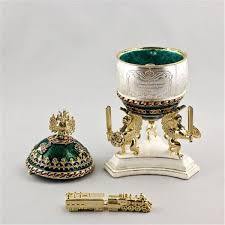
To commemorate the linking of two parts of Russia, the Trans-Siberian railway egg was created. Made by Mikhail Perkhin from the house of Faberge for Nicholas II to be presented to Empress Alexandria Fyodorovna in the year 1900. The upper hinge of the golden egg is coated with green enamel with insets of acanthus leaves, crowned with a three-headed eagle with a golden imperial crown. The body of the egg is engraved with the map of the trans-Siberian railway, marked by precious gemstones that form a girdle around the egg. Three gild-plated silver griffin serves as the base of this imperial egg. The egg serves as a house to a miniature replica of the steam-powered train. Divided into three sections, made of platinum and gold with a diamond headlight and ruby stoplights. Five carriages with labels like male, women, smoking, non-smoking, and chapel can be seen on the rock crystal windows. The surprise is a functional train that can be wind up to run. Its original cost was 7,000 rubles and is currently housed by the Armory Museum of Kremlin.
Cockerel Egg
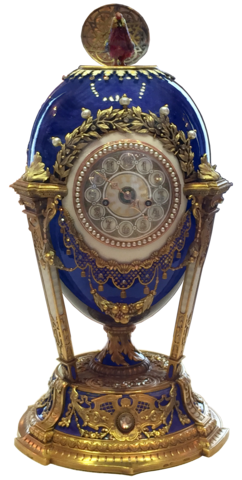
Made by Mikhail Perkhin from the house of Faberge for Nicholas II to be presented to Maria Feodorovna in the year 1900. Also known as the cuckoo clock egg that has the mechanism that enables the bird to come out and move in the top of the egg. An ornamented table clock coated with translucent violet enamel with a translucent oyster enameled three-legged base. The dial of the clock is fashioned with flower heads enameled with a translucent green hue. The body is ornamented with pearls, laces, and decorated with tassel and fruits. Its original cost was 6,500 rubles, one of the nine imperial eggs that cost $100 million bought by Viktor Vekselberg.
Flower Basket Egg (1901)
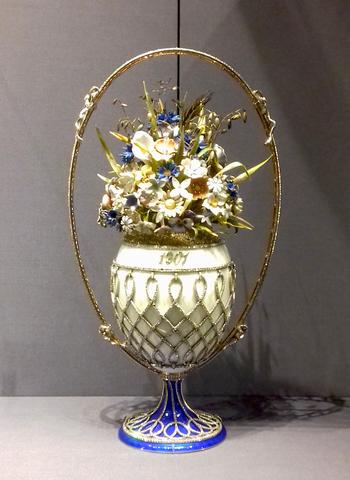
Made by Mikhail Perkhin from the house of Faberge for Nicholas II to be presented to Empress Alexandria Fyodorovna in the year 1901. This specific Imperial egg did not contain a hidden surprise and was previously doubted to be a part of the imperial egg series. However, the inventory proved that the flower basket egg was designed as it is. The gold egg was initially held by a white enameled stand with a gold basket handle decorated with diamonds. The exterior of the egg is covered with lattice with rose-cut diamonds and topped with a variety of colored flowers.
Gatchina Palace
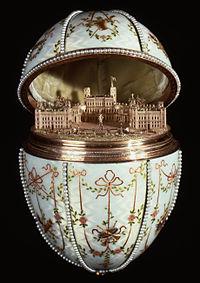
Made by Mikhail Perkhin from the house of Faberge for Nicholas II to be presented to Maria Feodorovna in the year 1901. A white enameled god egg, painted with green and golden leaves, ribbons, and bows with pink roses, with the flaming torches of arts and science. Portioned in 12 segments lines with pearls and two diamonds on each side. The egg houses a detailed miniature of the Gatchina Palace, where the Dowager Empress takes residence. According to a letter from Dowager Maria, former Tsar Alexander loved the Gatchina palace, as he wants to get out of the city during winter. This was the place where Tsar Nicholas had lived a simple life that his father wanted them to experience. The egg was created to commemorate their memories of the place. Its original cost was 5,000 rubles and is permanently housed in Walters Art Museum. Its initial cost was 6,850 rubles and was later bought by an unnamed buyer for $1,000. It is now in possession of Queen Elizabeth II.
Clover Leaf

Made by Mikhail Perkhin from the house of Faberge for Nicholas II to be presented to Empress Alexandria Fyodorovna in the year 1902. A gold egg intricately covered with tightly knitted clover leaves, paved with diamonds and rubies. Supported by a graceful three curving stems made of gold. The lost hidden surprise was said to be a four-leaf shaped clover with portraits of the tsars four daughters namely: Olga, Tatiana, Maria, and Anastasia. Adorned with twenty-three pieces of diamonds, its original cost was 8,750 rubles; it is currently kept in the Armory Palace of Kremlin.
Empire Nephrite

Made by Mikhail Perkhin from the house of Faberge for Nicholas II to be presented to Maria Feodorovna in the year 1902. Described to be fashioned in an Empire style egg made of nephrite, a medallion portrait of the late tsar Alexander III, and decorated with two diamonds. This description is base do the inventory list of all the imperial egg, but the piece that belongs to a private collection in New York is described to be an egg of gold base with tow nephrite pillars with the portraits of the duchess Olga and Duke P.A. This description was said to be found in the Gatchina palace written by the Dowager Empress herself.
Peter the Great
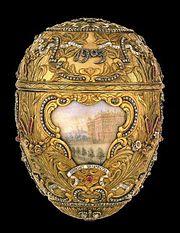
To memorialize the 200th anniversary of the foundation of Saint Petersburg, Peter the great egg was created. Fashioned by Mikhail Perkhin from the house of Faberge for Nicholas II to be presented to Empress Alexandria Fyodorovna in the year 1903. An egg made of a mixture of yellow gold, platinum in yellow and green hues. Diamonds and rolls of rubies can be seen on the body of the egg. It also features four painted places like the Peter Palace, The wooden hut, Nicholas II, and one thousand room winter palace. Laurel leaves can be seen on the body of the egg that denotes pride, triumph, and faithfulness. The egg houses the minute detailed replica of Peter the Great on horseback mounted on a sapphire base. Its original cost was 9,760 rubles and was acquired by Lillian Thomas Pratt for $16,500.
Royal Danish Egg
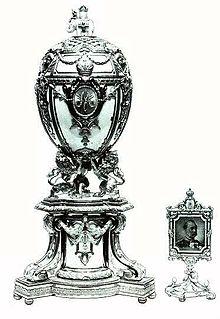
Made by Mikhail Perkhin from the house of Faberge for Nicholas II to be presented to Maria Feodorovna in 1903. This imperial egg is still considered lost and can only be described via a photograph. The egg was created to commemorate Alexander III. Related to have been enameled with light blue and white hues, decorated with gold and gemstones. Crowned by a royal elephant held by three Danish lions. The egg houses tiny portraits of the late Christian IX of Denmark, Louise of Hesse-Kassel, and Dowager Maria. Its original cost was 7,535 rubles, still considered lost at present.
Moscow Kremlin Egg
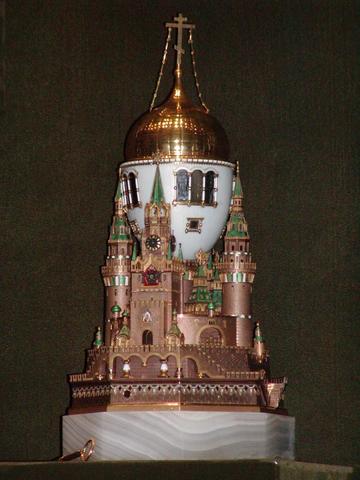
Made by Mikhail Perkhin from the house of Faberge for Nicholas II to be presented to Empress Alexandria Fyodorovna in 1906. The most significant imperial egg. Inspired by the Dormition cathedral where all the Tsars were crowned. This complexly designed egg has a removable cathedral dome. Intricate parts of the cathedral were replicated like the carpets, the altar, and even the Spassky tower. This massive imperial egg houses a music box that is placed on the base of the egg. When winded, it plays the favorite anthem of Tsar Nicholas II, the Izhe Khveruviny. Its original cost was 11,800 rubles and is currently held in reserve in the Armory of Kremlin.
Swan Egg
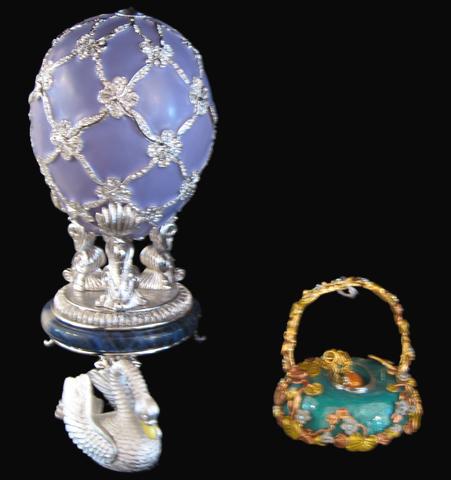
Made by an unknown workmaster from the house of Faberge for Nicholas II to be presented to Maria Feodorovna in 1906. A gold egg covered with a matte mauve enameled surface with interlaced ribbon trellis adorned with rose-cut diamonds, a large portrait diamond is positioned the top and the bottom of the egg to cover–up the division when closed. The egg houses a miniature mechanical silver and gold swan on a piece of an aquamarine lake that moves its neck and wings when winded. A symbol of permanence and a marriage. The swan feature was inspired by the silver swan of James cox that Faberge once saw on Paris world's fair. Its original cost was 7,200 rubles and is currently owned by the Edouard and Maurice Sandoz Foundation.
Rose Trellis
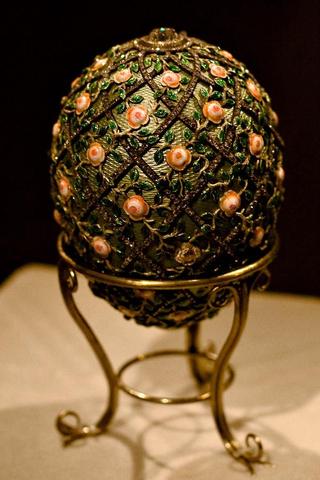
Made by Henrik Wigstrom from the house of Faberge for Nicholas II to be presented to Empress Alexandra Fyodorovna in the year 1907. A gold egg exhibits a combination of translucent and opaque light green enamel, adorned with pink enamel rose-tree branches and green enamel leaves. Two-portrait diamond on each side of the egg. The egg houses a diamond necklace, a tiny diamond framed portrait of the crowned prince on a piece of ivory. Its original cost was 8,300 rubles and is currently owned by Henry Walters. It is available for display in the Walters Art Gallery.
Love Trophies
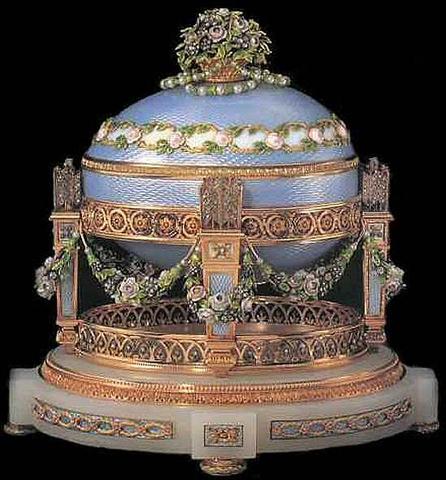
Also known as the cradle with garland eggs, made by Henrik Wigstrom from the house of Faberge for Nicholas II as a gift to Dowager Maria Feodorovna in 1907. A gold egg coated with a translucent light blue enamel exhibiting a Louise seize styles. Elaborately fashioned with painted roses, leaves, and panels made of enamels. Bands of scrolls and gold acanthus plants can also be seen on the body of the egg. Topped by a golden basket with flowers and foliage with drapes of pearls and rose-cut diamonds. The egg was supposed to house miniature replicas of the royal children though it cannot be proven for the surprise that cannot be found. Its original cost was 9,700 rubles and was housed in the Gatchina Palace. Robert Lee is the current owner of this imperial Easter egg purchased for $3,190,000.
Alexander Palace (1908)
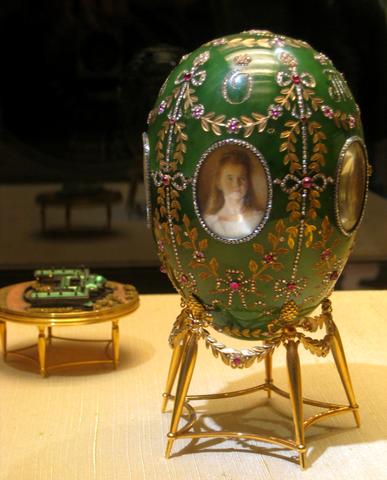
Made by Henrik Wigstrom from the house of Faberge for Nicholas II as a gift to Empress Alexandra Fyodorovna in the year 1908. Made from nephrite, five painted portraits of the royal children are shown on the body of the imperial egg initials of Empress Alexandra with the year of 1908 with a set of diamonds within a wreath of flowers and gold leaves adorned with rubies and shards of diamonds. The egg houses a detailed mockup of the Alexander Palace made with coated gold and silver. Completed with windows made from rock crystal, enameled roof fixed on a golden table with five narrow posts. Its original cost was 12,300 rubles; the imperial egg is currently reserved in the Armory Museum of Kremlin.
Peacock
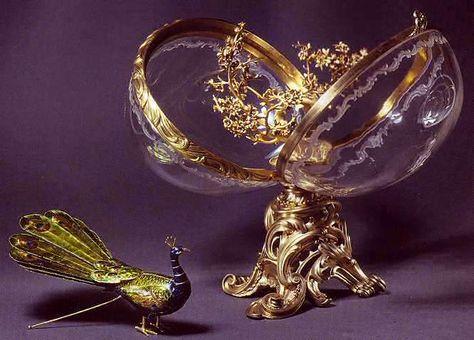
Made by Henrik Wigstrom from the house of Faberge for Nicholas II as a gift for Dowager Maria Feodorovna in the year 1908. A translucent egg made from rock crystal held by a gilded silver of base. The transparent egg houses a mechanical peacock perched on a gold branch with flowers. When winded and placed on a flat surface, it walks proudly, moves its head as well as alternately open and close its colorful tail. Its original cost was 8,300 rubles, acquired by Wartski in the year 1958 for 6,000 pounds. It is a part of the Collection of Edouard and Maurice Sandoz.
Standart Yacht Leaf Egg
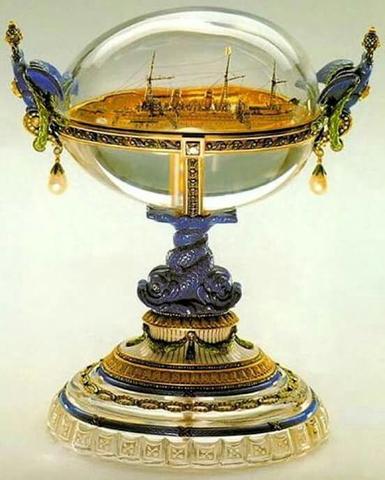
Also known as the Standart of 1990. Made by Henrik Wigstrom from the house of Faberge for Nicholas II as a gift for Empress Alexandra Fyodorovna. A transparent egg made from rock crystals marked in half by a gold band formed of green enameled leaves with small shards of diamonds. The two-crowned eagle perched on the left and right side of the horizontally mounted supported by two dolphins made from lapis lazuli. The transparent egg houses a gold model of the imperial yacht made from gold and platinum that rest on a carved crystal. Its original cost was 12, 400 rubles, and is currently held in reserve in the Armory Museum of the Kremlin.
Alexander III Commemorative
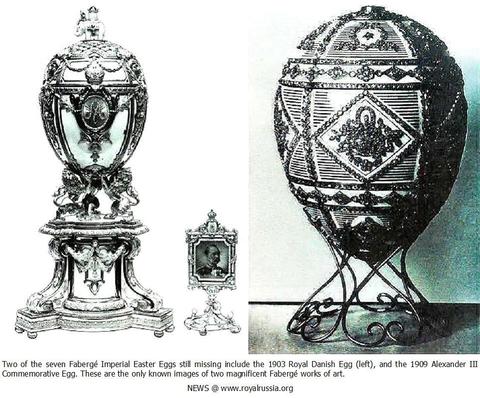
One of the three commemorative eggs for Alexander III. Made by the house of Faberge for Nicholas II as a surprise for Dowager Maria Feodorovna in the year 1909. Made from a platinum base coated with a matte white enamel decorated with gold lines. Divided into five segments, with lines of laurel leaves with rose-cut diamonds. The star of Bethlehem paved with diamond enclosed with a wreath placed near the apex. The Easter egg was supposed to have a detailed gold bust of the late Alexander III. Its original cost was 11,200 rubles, while its location is still unknown.
Colonnade Egg
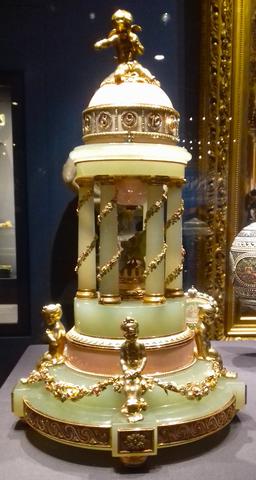
Made by Henrik Wigstrom from the house of Faberge for Nicholas II as a gift for Empress Alexandra Fyodorovna in the year 1910 to commemorate the birth of the crown prince, which denotes a direct heir to the throne, a fully functional clock egg that features a dome top enameled with opalescent pink topped with a cupid made from gilded silver. White dial with rose-cut diamond-paved Roman numerals, completed with a pointer made from bowenite. Supported by six pillars of light green bowenite, these are attached on chiseled gold bases with a full band with coated pink enamel. Four cherubs that rest on the four corners representing the four imperial daughters. The clockwork built within this egg is made the Henry Moser & Cie, its original cost was 11,600 silver rubles and is now in possession of Queen Elizabeth II.
Alexander III Equestrian Egg
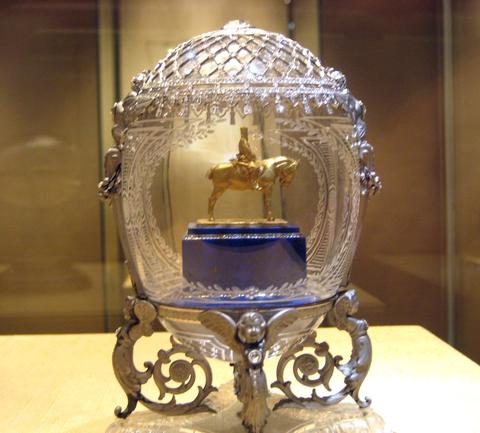
Made by an unknown worker form the house of Faberge for Nicholas II to present as a gift to Dowager Maria Feodorovna in 1910. The egg houses to a detailed mini statue of Alexander III on horseback made of gold mounted on a rectangular lapis lazuli with two bands of rose-cut diamond-paved borders. The exterior of the egg is craved from a rock crystal engraved with a laurel wreath. The top of the egg is adorned with a mesh with tasseled fringes made of platinum material. Two platinum crowned double head eagle rest on each side, supported by four coiled bases with a cherub shape made from cast platinum. It is reserved in the Kremlin Armory Museum.
Fifteenth Anniversary

Miniatures made by Vasilii Zulev, and egg by workmaster Mikhail Perkhin from the house of Faberge for Nicholas II to present as a gift to Empress Alexandra Fyodorovna for the year 1911. An egg made of red gold with white and green enamel. The surprise is decorated with an intersecting lattice of green laurel leaves adorned with rose-cut diamonds. Each of the eighteen panels has portraits such as the painter portrait of Nicholas II, The Russian Imperial Historical Museum, and the Processional ceremony to Unspenski Cathedral. The inaugural of the Alexander III Bridge. Huis ten Bosch and other celebrations. Empress Alexandra's imperial signs set on a top of the egg, the egg is supported by a gold base. Its original cost was 16,600 silver rubles; it belongs to the collection of imperial eggs bought by Viktor Vekselberg and is now on display at the Faberge Museum. The egg was supposedly to be made with red enamel but as the crowned prince was diagnosed with Hemophilia, it was later change to green as a sign o respect to the Royal family.
Bay Tree (1911)
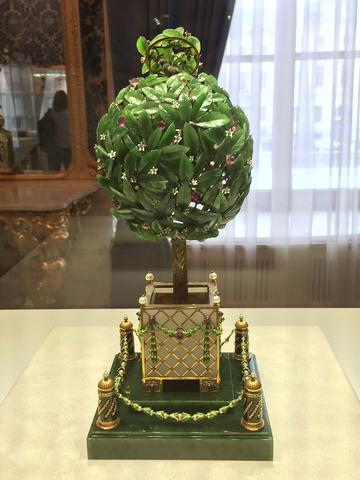
Also known as the orange tree egg of 1911, made by an unnamed workmaster from the house of Faberge, made from gold trunk extending to four major branches decorated with green leaves made of nephrite. White enameled flowers adorned with a diamond center. Fruits are made of rubies and champagne-colored diamonds. By turning the lever concealed as a fruit, the surprise rises up from the tree. The egg houses a songbird that rises from the tree and flaps its wings; it then opens its mouth and sing. The inspiration for this tree came from an orange tree by a jeweler in Paris. Its original cost is 12,800 silver rubles; it belongs to the collection of imperial eggs bought by Viktor Vekselberg and is now on display at the Faberge Museum.
Czarevich or Tsesarevich Egg

Made by Mikhail Perkhin from the house of Faberge for Nicholas II to present as a gift to Empress Alexandra Fyodorovna in the year 1912. Embodies by a Louis XV style, an egg made from carved lapis lazuli decorated with excellent cage works of shells m cherubs, flowers, and the imperial double-headed eagle in gold. The typical rectangular portrait diamond with the year it was made, engraved, and place on top of the egg. The egg would hold a mini painted portrait if the Empress mounted on a lapis lazuli base paved with diamonds. A crowned double-headed eagle made from two thousand pieces of rose-cut diamonds set behind the Empress's portrait. Its original cost was 28,597 silver rubles and is currently a part of the Lillian Thomas Pratt collection.
Napoleonic Egg

Also referred to as the Imperial Napoleonic egg of 1912, made by Henrik Wigstrom from the house of Faberge, miniatures made by Vasilii Zuiev for Nicholas II as a present for Empress Maria Feodorovna. Made of gold, empire green enamel. Four vertical and six horizontal intersecting lines with a ruby red guilloche enamel with lines of laurel leaves. Six main panels display detailed features of the Imperial double-headed eagle and various military trophies. It houses a six-paneled extended octagon frame with miniature paintings that shows the members of the Empress regime. More details were engraved at the back of the portrait.
This egg commemorates the hundredth anniversary of the war against Napoleon. Its original cost was 22,300 silver rubles; its current owner is the Matilda Geddings Gray Foundation.
Romanov Tercentenary (1913)

Made by Henrik Wigstrom from the house of Faberge, miniatures made by Vasilii Zuiev for Nicholas II as a present for Empress Alexandra Fyodorovna in the year 1913. An egg to commemorate the 300years of the Romanov regime, it features a gold egg coated with translucent white enamel, chased gold of traditional crowns of the Romanov and its imperial crest. Portraits of the eighteen Romanov rulers painted on each panel framed with rose0-cut diamond setting. The egg sits on a golden wedge-shaped imperial eagle; each holds a staff, orb, and the imperial sword. The base is made of gold and purpurine adorned with gems to resemble the Imperial shield.
The egg houses a rotating globe, halved and enameled with a royal blue color. Each half shows the historic and modern Russian regions of the years 1613 and 1913. The blue-colored enamels depict the waters while the gold represents the lands. Its original cost was 21,300 silver rubles and is currently housed in the Armory Museum of Kremlin.
Winter Egg

Made by Albert Holstrom and designed by Alma Theresia Pikl from the house of Faberge for Nicholas II as a present to Dowager Maria Feodorovna in the year 1913. This fantastic Easter egg was a symbol of the change from winter to spring. Spiritually speaking, the beginning of new life and the resurrection from death. Inspired by the icicle seen on the windowpane, the winter egg was created. Made from high-quality rock crystal, decorated with an ice theme, it consists of 1,308 rose-cut diamonds adorned all over the icicle egg. The inner and outer body of the egg is delicately carved to replicate ice crystals, the egg sits in a block of melting ice made from a crystal rock. The egg holds a flower basket made from platinum. The flowers are intricately carved from white opal connected to golden wires with carved green nephrite for the leaves. Its original coast was 24,600 silver rubles and was sold to the Shriek h of Qatar for a whopping $9,579,500 in 2002. It is housed in the Qatar Authority Museum.
Mosaic
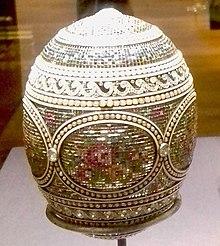
Made by Albert Holstrom and designed by Alma Theresia Pikl from the house of Faberge for Nicholas II as a present to Empress Alexandra Fyodorovna in the year of 1914. This piece was said to have pushed Mr. Holstrom to insanity due to the elaborate and intricate design. The designer was inspired by the embroidery of her mother-in-law and the watercolor brooch design of Mr. Hosltrom. The gold egg is made up of a variety of gems; it has five oval panes with flower patterns. A diamond is set in between the panels and the gold belts.
It holds an oval-shaped group carved portrait if the five imperial children framed with gold, pearls and rose-cut diamonds. The rear side of the picture displays an enameled basket of blossoms. With the name and the year of the five children. The original cost was estimated to be 28,300 silver rubles, with Queen Elizabeth II as its current owner.
Grisaille (1914)

Also referred to as the Catherine the Great egg of 1914. Made by Henrik Wigstrom from the house of Faberge, miniatures made by Vasilii Zuiev for Nicholas II as a present for Dowager Maria Feodorovna. Fashioned by a Louise Seize style, two large paintings of analogies of arts and science on the front and rear of the egg with two oval-shaped panes with pictures of cupids personifying each season. Each frame is bordered with two-toned gold with rose-cut diamond sets. Chased multi-colored gold of musical plaques and laurel foliage are placed all over the surface of the egg. The surprise of the egg is currently missing however it was said to house a miniature replica of Catherine the great on an automated sedan chair. This description is based on a letter wrote by the late Empress Maria Feodorovna to her sister. The original cost was 26,800 silver rubles, it was bought by the Eleanor Barzin for her mother, Marjorie Post. The egg is part of the Collection of the late Marjorie Post displayed at the Hill wood Museum.
Red Cross with Imperial Portraits
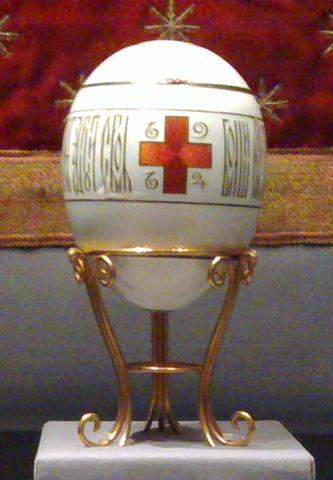
Made by Henrik Wigstrom with miniatures made by Vasilii Zuiev from the house of Faberge for Nicholas II as a present to Dowager Maria Feodorovna in the year of 1915. This egg is made to commemorate the service of Dowager Maria Feodorovna to the Red Cross. A silver egg, enameled with opalescent white with two large Red Cross-shaped enamel, gold enamel script design on the body of the egg with the imperial monogram of the Dowager Maria in silver. It holds five panels displaying portraits of Duchess Olga Nicolaievna, Duchess Olga Alexandrovna Dowager Maria Feodorovan, Duchess Tatiana Nocolaievna, and Duchess Marie Pavlovna. All are in their Red Cross uniforms with their monogram at the back. Its original cost was 3,875 silver rubles and was later bought by Lilian Thomas. It is now a part of the late Lillian Thomas Pratt collection in Virginia Museum of Fine arts.
Red Cross with Triptych Egg

Made by Henrik Wigstrom with miniatures made by Vasilii Zuiev from the house of Faberge for Nicholas II as a present to Empress Alexandra Fyodorovna in the year of 1915. The egg is made of gilded silver with snowy white enamel. Ornamented by a Red Cross with a round central portrait of Duchess Olga and Tatiana wearing their Red Cross uniforms. The portrait of Duchess Tatiana functions as an opening to the triptych. Inside is a watercolor of the Harrowing hell in the middle, Saint Olga on the left, and Saint Tatiana on the right. Its original cost was 3,600 silver rubles; it is currently a part of the Collection of the late India Early Minshall displayed in Cleveland Museum of Art.
Steel Military
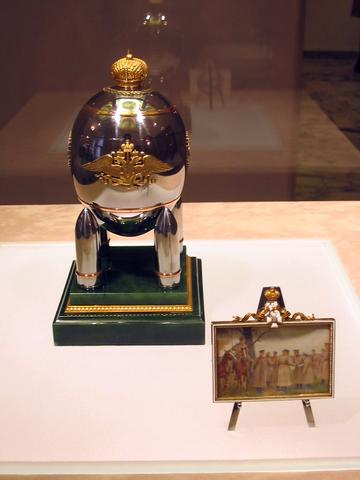
Made from the house of Faberge for Nicholas II as a present to Empress Alexandra Fyodorovna in the year of 1916. A steel egg topped with a golden imperial crown and the main decor of the Royal Emblem of the Russian Empire segmented with three horizontal lines. Four gun shells support the egg when opened; it reveals a miniature portrait of Sir George, the conqueror with the frame defined by laurel leaves. The same as the Order of Saint George egg, the exact cost of this egg is unknown, it is currently reserved at the Armory Museum of the Kremlin.
Order of St. George
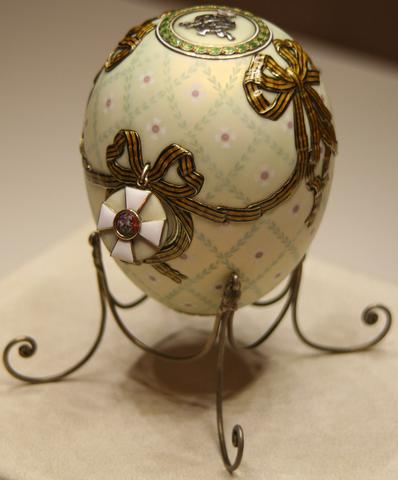
Made by Henrik Wigstrom with miniatures made by Vasilii Zuiev from the house of Faberge for Nicholas II as a present to Dowager Maria Feodorovna in the year of 1916 to commemorate the order of Saint George. A silver egg coated with white enamel decorated with draped of laurel garlands with golden ribbons enameled using the colors of the order. The typical cipher of the recipient with the year it was given is engraved at the base of the egg. It holds two medallions with each portrait of Tsar Nicholas II and the Tsarevich Alexei underneath the Cross of Saint George. The emblem reveals the paintings of the royals when pressed. The egg currently resided in the Faberge Museum Saint Petersburg.
Karelian Birch and the Constellation (1917)
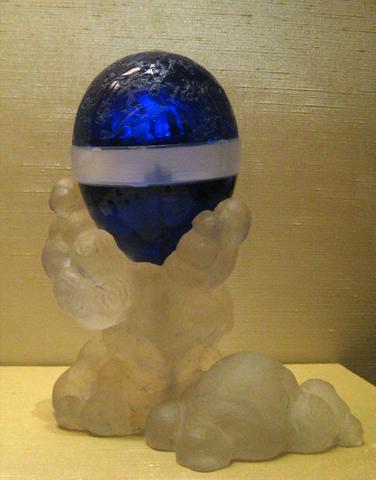
Two unfinished Imperial Eggs due to the revolution. Some of the descriptions were made through the surviving sketches and studies.
Here is the round up the whereabouts of the Faberge eggs made for the imperial family.
- Ten of the eggs are held in reserve in the Kremlin Armory Museum in Moscow.
- Thirteen are in different museums displayed throughout the USA.
- Cleveland Museum of Art.
- Virginia Museum of Fine arts
- Walters Art Gallery.
- Hill wood Museum in Washington
- New York at the Metropolitan Art Museum
- Nine of them are on display in the Links of time museum in Saint Petersburg.
- Three are currently with the Queen Elizabeth II of London.
- One belongs to Prince Albert II of Monaco
- Seven are still missing.
- One in Qatar Authority Museum.
Kelch Eggs (Alexander Kelch)
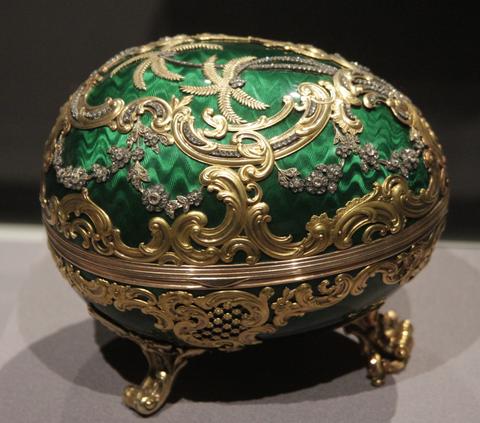
The house of Faberge also made ornamented eggs for other people other than the imperial family.
Hen (1898)
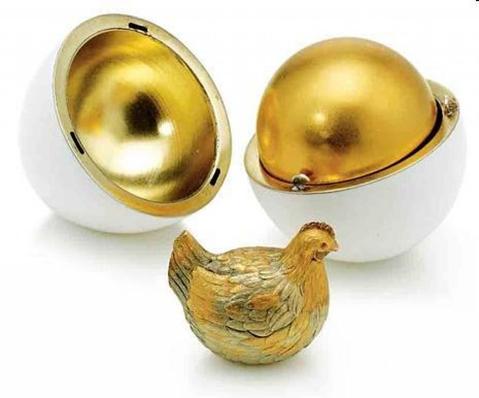
A gold egg enameled with a strawberry red hue. Adorned with the typical Faberge rose-cut diamonds. Once opened, it reveals a flat white enameled portion represents the egg white, it holds a yellow enameled round yolk that contains gold and brown enameled hen, which in turn shows a miniature portrait of Barbara Kelch. Viktor Veksleberg is the current owner of this piece.
Twelve Panel (1899)
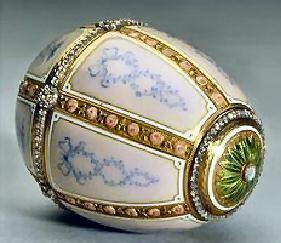
Made by Mikhail Perkhin from the house of Faberge to Alexander Kelch. A twelve-paneled opalescent white enameled golden egg with gold borders decorated with enameled rosettes, gold stems, and green enameled leaves. Three bands of horizontal edges decorated with rose-cut diamonds. Queen Elizabeth II currently owns this piece.
Pine Cone (1900)
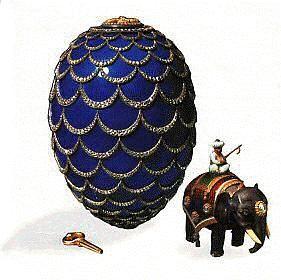
Made by Mikhail Perkhin from the house of Faberge to Alexander Kelch. A gold egg coated with royal blue enamel. Decorated with drapes of rose-cut diamonds. When opened, it reveals a mini elephant made of silver and gold with a man sitting on it. The pine cone egg was said to be a symbol of resurrection like the other Easter Eggs. The elephant walks, moves its head as well as wags its tail when winded.
Apple Blossom (1901)

Also referred to as the Jade Chest egg, An egg made from carved nephrite supported by four curved gold trunks legs that crawl upward into interconnected branches decorated with white and pink enameled petals set with rose-cut diamonds. The surprise within the egg is still unknown. Currently owned by the Liechtensteinisches Landes Museum.
Bonbonniere (1903)
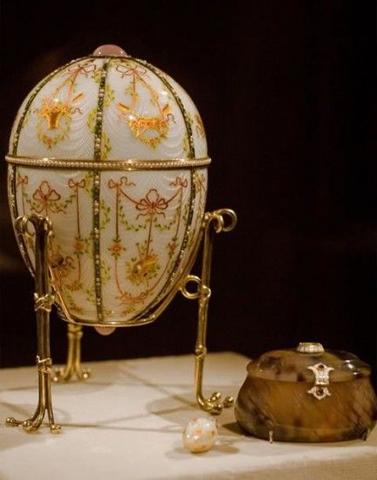
Made by Mikhail Perkhin from the house of Faberge to Alexander Kelch. A gold egg enameled with pearly white color, twelve panels segmented by gold bands paved with rose-cut diamonds. Fashioned using a neoclassical style with hanging floral baskets and with ribbons. Ornamented with cabochon rubies, the egg holds a bonbonniere box in which conceals a miniature egg pendant with the same feature as the exterior shell. Currently owned by Estate of the late Kerry Packer. The workmaster did not sign this piece, although it resembles the imperial Gatchina egg.
Chanticleer (1904)
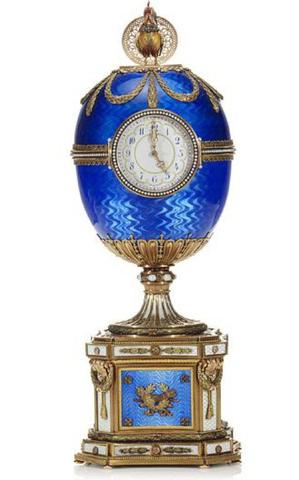
Made by Mikhail Perkhin from the house of Faberge to Alexander Kelch. The egg holds a gold Chanticleer paved heavily with rose-cut diamonds, an automated bird that flaps its wings when the clock strikes an hour. A fully functional clock made from gold, enameled with a royal blue color. Chased gold drapes of laurels on top of the egg, supported by a square-shaped base with enameled green and gold bellflowers, acanthus and laurel swags. Currently owned by The Link of Times-Collection.
Other Faberge eggs
Duchess of Marlborough Egg (1902)

Also referred to as the pink serpent. Made by Mikhail Perkhin from the house of Faberge to Consuelo, the Duchess of Marlborough. Like the blue serpent egg, this does not contain anything inside. Enameled translucent pink egg is decorated with diamonds paved gold bands set on the top and the bottom of the egg. It is raised on a single base like a chalice with a serpent facing up, pointing its head and tongue to the roman numerals that indicate the time. This is a working clock with a rotating white enamel to tell the time. Its original cost was 5,000 silver rubles and is currently owned by Viktor Vekselberg.
Rothschild Egg (1902)

Made by Mikhail Perkhin from the house of Faberge for Beatrice Ephrussi de Rothschild. This egg resembles the Chanticleer egg. The egg holds a varicolored cockerel paved with rose-cut diamonds, an automated bird that flaps its wings when the clock strikes an hour. A fully functional clock made from gold, enameled with ruby red color. Chased gold drapes of laurels on top of the egg, supported by a square-shaped base with a central gold cross sword emblem. It is currently housed in the State Hermitage Museum.
Youssoupov Egg (1907)

Also referred to as Sandoz Youssoupov Egg, made by the house of Faberge for Prince Felix Yusupov to present as a gift for his wife Zenaida for their 25th wedding anniversary. A gold egg enameled with a pink hue designed a rotating clock like the blue serpent having a white rotating dial with Roman numeral set with rose-cut diamonds. A heavily paved rose-cut diamond coiled serpent surrounds the upper part of the eff with its diamond crowned head and tongue pointing down to tell the time. A medallion with chased gold with the letter Y and S on ivory, decorated with golden drapes. Edouard et Maurice Sandoz Foundation is the current owner of this Faberge egg.
Nobel Ice Egg (1914)

Also referred to as the snowflake egg, made by the house of Faberge for Dr, Emmanuel Noble as a present for a friend. Inspired by the winter egg with a platinum base enameled with opalescent white with and carvings of snowflakes. The opening of the Easter egg is lined with seed pearls. It houses an enameled pendant clock. It is currently a part of the McFerrin Collection USA.
Spring Flowers Egg (1899-1903)

Made by Mikhail Perkhin from the house of Faberge for an unnamed close friend of Maria Feodorovna, a gold egg enameled in red glass with chased gold scrolls supported by a stand made of bowenite and gold. It reveals a basket of flowers made from intricately carved white enamel and nephrite for the leaves. Viktor Vekselberg is the current owner of this egg.
What makes the Faberge egg unique and expensive? It is not the value of the material used; it is the creativity, superior artistry, and the history behind all his work. The imperial eggs were the best pieces that Faberge had ever made, the intricacy and the detailed features from the color to the littlest features of a door handle. His artworks also highlight the wealth of Russia by using gems and stone native to their country. All the imperial eggs were designed and crafted to commemorate special events like the coronation of Tsar Nicholas and Empress Alexandra. To honor a well-loved person and their life like the late Tsar Alexander III and the service made by Dowager Maria. These are the reasons why Faberge and the Faberge eggs are highly valued and considered as a part of history.

4 comments
What a beautiful article. Thank you. I hope the lost will be found one day and shared with the world.
I like most of the eggs, but the bay tree isn’t even egg shaped, and as such I think it should be removed from the list.
All of these eggs are truly magnificent and also the history of them is fascinating. What a pity some are lost .
I never realized how magnificent the Faberge eggs were—Such precision and craftmanship and quality of the materials make them worth the prices that are paid —-their beauty is beyond comparison
thank you for making this article avilable